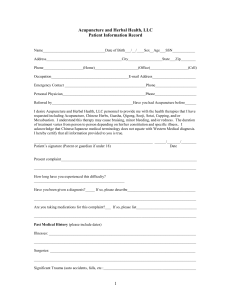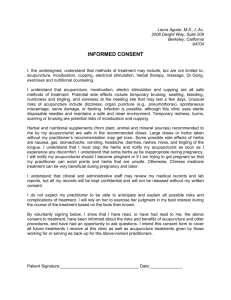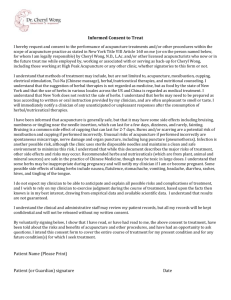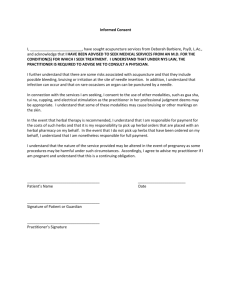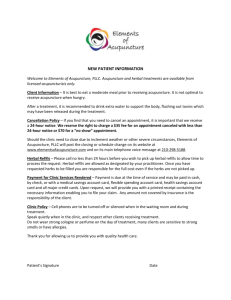Lecture Notes Unit 1
advertisement
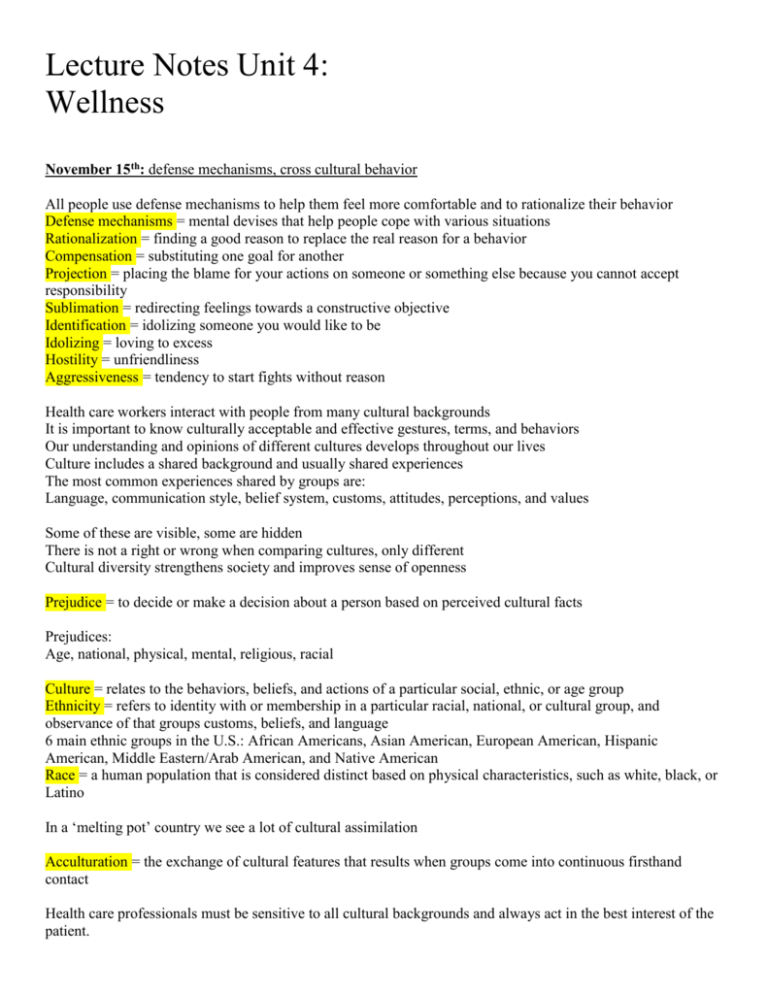
Lecture Notes Unit 4: Wellness November 15th: defense mechanisms, cross cultural behavior All people use defense mechanisms to help them feel more comfortable and to rationalize their behavior Defense mechanisms = mental devises that help people cope with various situations Rationalization = finding a good reason to replace the real reason for a behavior Compensation = substituting one goal for another Projection = placing the blame for your actions on someone or something else because you cannot accept responsibility Sublimation = redirecting feelings towards a constructive objective Identification = idolizing someone you would like to be Idolizing = loving to excess Hostility = unfriendliness Aggressiveness = tendency to start fights without reason Health care workers interact with people from many cultural backgrounds It is important to know culturally acceptable and effective gestures, terms, and behaviors Our understanding and opinions of different cultures develops throughout our lives Culture includes a shared background and usually shared experiences The most common experiences shared by groups are: Language, communication style, belief system, customs, attitudes, perceptions, and values Some of these are visible, some are hidden There is not a right or wrong when comparing cultures, only different Cultural diversity strengthens society and improves sense of openness Prejudice = to decide or make a decision about a person based on perceived cultural facts Prejudices: Age, national, physical, mental, religious, racial Culture = relates to the behaviors, beliefs, and actions of a particular social, ethnic, or age group Ethnicity = refers to identity with or membership in a particular racial, national, or cultural group, and observance of that groups customs, beliefs, and language 6 main ethnic groups in the U.S.: African Americans, Asian American, European American, Hispanic American, Middle Eastern/Arab American, and Native American Race = a human population that is considered distinct based on physical characteristics, such as white, black, or Latino In a ‘melting pot’ country we see a lot of cultural assimilation Acculturation = the exchange of cultural features that results when groups come into continuous firsthand contact Health care professionals must be sensitive to all cultural backgrounds and always act in the best interest of the patient. i.e. Muslim women may not be examined by male members of the medical community Catholic doctors ethically should refer women seeking an abortion November 20th: gestures, body language, personal space Personal space and touching – defined differently in different cultures, close-contact to distant-contact, touching can be misunderstood, some south Asian cultures believe that a person’s spirit is on the head so touching the head is an insult. CLOSE CONTACT: Africa Indonesia Latin America Hispanic Americans Mediterranean Southern Europe French Greet by kissing on cheeks DISTANT CONTACT: Canada Great Britain Northern Europe U.S. Native Americans Middle Eastern Arabic Asian American Greet with handshake, hugs for close friends and relatives Greetings – important in all cultures, the way it is given and received often determines how positive or negative the meeting is GREETING GUIDELINES: Anglo American – shakes hand if desired Latin American – shake hands or hugs Cambodian or Laotian – do not shake hands, put hands together at different levels, equal = hands at chest, older or superior person or stranger = hands at chin, relative or teacher = hands at nose Vietnamese – salute by joining both hands and moving them against the chest Hmong (interior mountains of SE Asia peninsula) – bow head or shake hands Hand gestures – some mean different things in different cultures Wiggling finger is appropriate to call a person over in the U.S. – rude in many other cultures Sideways Pointing at a thing is ok in Asia, but not at a person, confrontational, in America its ok for person or thing Closed fist upright point – slight threat in America, strong threat made by superior in Asia (never used on girl) Eye contact – sometimes means a person is listening, sincere, or honest, or hostile or disrespectful EYE CONTACT: Anglo American – important, interest, honesty, listening African American – not as important, being in same room indicates attentiveness Navajo – direct eye contact avoided, peripheral vision used, direct stares are considered hostile or a way to scold children Japanese, SE Asian, Hispanic – eye contact is avoided as a form of respect Family organization – important in all cultures, nuclear families, extended families, patriarchal or matriarchal Asia – mostly patriarchal, extended, family needs more important than individual needs November 27th: spirituality and religion in medicine Folk medicine is a collection of traditional beliefs and customs for treating pain or illness Mostly Western (biomedical) medicine in the U.S.- important to learn about your client’s culture though Common folk medicine practices from various cultures: Armenians: give mother a party 1 wk after baby is born, she is served bread, which she dips in a paste of margarine sugar and flour. Celebration of birth of child prohibit menstruating women from going to church, taking a shower, or eating spicy foods Asians: Think health is a balance of yin and yang Use treatments like acupuncture and herbal remedies Believe pain must be endured silently Cambodians: Use herbs as medicine Use cupping for headache Use coining for pain Consider the color white to be a sign of bad luck Central and South Americans: Use herbal home remedies Teach a menstruating woman not to get her head wet, and to avoid eating cucumbers, lemons, oranges, pork, lard, and deer meat Chinese: Use herbs as medicine Practice acupuncture Use cupping with heated bamboo Europeans: Believe that illness is caused by outside source Focus on treatment with medicine, surgery, diet, and exercise Hispanics: Believe that health is a reward from God Believe in good luck Use heat and cold remedies to restore balance Rely on prayers and massage Hmong and Mien Tribes: Perform spiritual ceremonies to please the spirits that cause illness Use herbal home remedies including opium Iranians: Believe that poor health is predetermined (fatalism) Use herbs, foods, rituals, and magic formulas for healing Believe the ‘evil eye’ causes sudden illness When Islamic, require washing of the face and hands before prayer Require periodic baths for cleansing Koreans: Practice alchemy Use acupuncture Go to hot springs for baths and rituals and massage Use energy and brain stimulants Middle Easterners: Believe that health is spiritual Cleanliness is essential Males dominate and make decisions on health care Believe in spiritual causes of illness like the ‘evil eye’ Native Americans: Use herbs and spices Use modern medical practices Some rely on a healer/shaman to remove pain and evil spirits Believe that health is harmony with nature Believe that tolerance of pain signifies power and strength Believe that illness is caused by supernatural forces and evil spirits South Africans: Believe in maintaining harmony of mind, body, and spirit Believe the causes of ill health are spirits, demons, or punishment from God Use prayer or religious rituals as treatment Vietnamese: Commonly use herbal medicine Use cupping Use acupuncture Spirituality Religious Agnostic Atheistic November 28th: communication Or work day for Folk Medicine Research Project.
